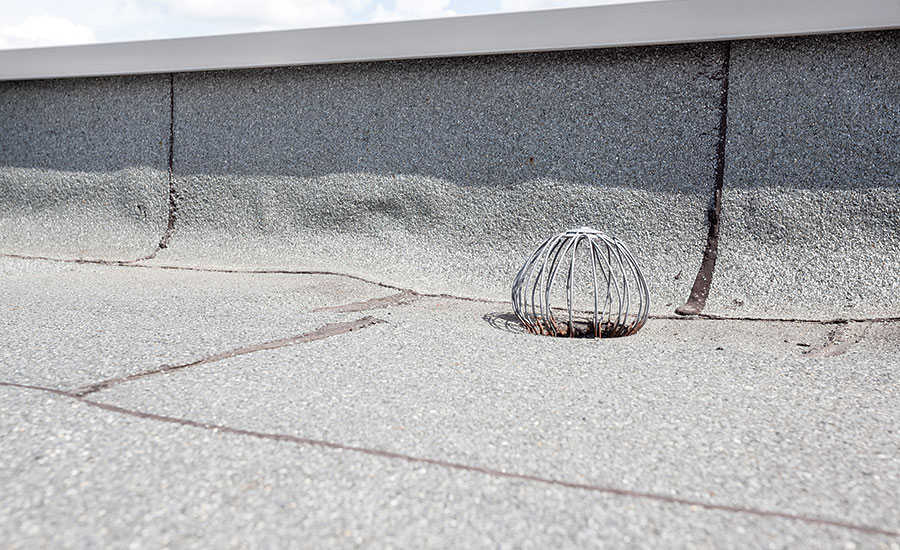In June, the ASME/CSA Committee met in Halifax, Nova Scotia, Canada to review the various A112 plumbing-fixture standards. One of the meetings held was on the roof drain standard. During that meeting, the never-ending dilemma regarding roof drain design arose.
The dilemma relates to the structural engineers’ approach to addressing roof loads based on the plumbing engineers’ design. Since the 1990s, structural engineers have had more to say about roof drainage than the plumbing engineers. What I mean by that is the structural loading is dictating the type of roof drainage design allowed for a building.
The plumbing engineer still has multiple options for roof-drainage design. However, the plumbing design will impact the calculations used for determining the roof load requirements for the structural design.
The ICC International Building Code (IBC) has requirements related to the structural loading of the roof based on possible ponding. The requirements are found in the first sentence of Section 1611.1, which reads: “1611.1 Design rain loads. Each portion of a roof shall be designed to sustain the load of rainwater that will accumulate on it if the primary drainage system for that portion is blocked plus the uniform load caused by water that rises above the inlet of the secondary drainage system at its design flow....”
These requirements also are a part of ASCE 7, which is referenced in the IBC. The interpretation of what constitutes blockage of the primary drainage system has created the dilemma for the design of roof drains and roof-drainage systems. The blockage is considered at the strainer of the roof drain. Hence, nothing is going down the primary roof drain.
The roof drain manufacturers have developed a single-body roof drain that has both the primary and secondary roof drain all in one body. The concept is brilliant since it reduces the number of roof drains, as well as locates the secondary roof drain in close proximity to the primary one.
The problem comes about when the primary and secondary roof drains are located under the same strainer. If there is a single strainer for both inlets, the IBC and ASCE 7 treat the secondary roof drain as being blocked, just like the primary roof drain. Therefore, even though there are two drains, primary and secondary, the IBC considers it one roof drain.
In order to address this dilemma the ICC International Plumbing Code (IPC) added requirements for the design of the strainer for combined primary and secondary roof drains. One sentence in Section 1108.1 of the IPC reads: “Where primary and secondary roof drains are manufactured as a single assembly, the inlet and outlet for each drain shall be independent.”
The IPC specifically prohibits a single strainer for the primary and secondary roof drain. If there is a combined primary and secondary roof drain, separate strainers would be required. Also, the secondary roof drain does not require a strainer, so there could be a single strainer for the primary roof drain and an open pipe for the secondary unit.
The continuing dilemma is that the roof drain standard (ASME A112.6.4) does not have any requirements regarding the strainer for combined primary and secondary roof drains. At the Halifax meeting, the subject came up for discussion again. At the previous meeting of the Roof Drain Standard Committee, the members voted to require separate and independent strainers for combined roof drains. In Halifax, the committee members voted to further study the issue.
A change proposed to the IAPMO Uniform Plumbing Code (UPC) requiring separate and independent strainers similar to the IPC was not approved at the May meeting. The concern raised by the Plumbing Technical Committee was that the requirement for separate strainers may be proprietary. It was a point of discussion raised by a testifier opposed to the code change.
Of course, having separate and independent strainers for a combined primary and secondary roof drain is not proprietary. Furthermore, the design under the UPC must still deal with the structure requirements of the IBC. So, even though it is not stated, a single strainer for the primary and secondary roof drain in the UPC would only count as a primary roof drain under the IBC. Thus, either another secondary drain would have to be installed or the roof loads would be based on the water ponding to the top of the parapet.
While the roof drain committee studies the issue, realize that with all the studying in the world, if you have a single strainer, the roof drain only counts as a primary drain. If the ASME standard is changed to reflect this requirement, it will be a service to all the roof drain manufacturers. Until then, they have a dilemma whereby they can get into trouble if there is a roof collapse. In your design, be sure to have separate strainers if you specify a combined primary and secondary roof drain.
ICC water conservation decision
On a completely different subject matter, the ICC Board of Directors issued its ruling regarding the requirements for water conservation. There were six code changes submitted to the ICC International Energy Conservation Code (IECC) during the last cycle regarding water conservation covering flow rates and flush volumes. An appeal was filed claiming the changes should not have been accepted to the IECC since this was an area that was regulated by the IPC.
Of the six code changes, only one was approved by the ICC membership involving commercial showerheads. The ICC Board of Directors set aside the code changes and ruled water conservation is regulated by the Plumbing Code and not the Energy Code. This happened to be the recommendation given by the ICC Code Correlating Committee. The Code Correlating Committee is responsible for evaluating the scoping requirements of all the ICC codes.
By the board’s ruling, all future changes involving water conservation must be submitted to the Plumbing Code. This change will be reflected in the scoping requirements that identify which code-change committee regulates a given subject matter.
The ICC Board of Directors addressed the issue professionally. The outcome is a success for the plumbing profession, which should be the guardians of the water use in plumbing fixtures.
This article was originally titled “Roof drain dilemma” in the August 2017 print edition of PM Engineer.


